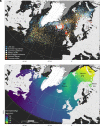Seabirds reveal mercury distribution across the North Atlantic
- PMID: 38739784
- PMCID: PMC11126949
- DOI: 10.1073/pnas.2315513121
Seabirds reveal mercury distribution across the North Atlantic
Abstract
Mercury (Hg) is a heterogeneously distributed toxicant affecting wildlife and human health. Yet, the spatial distribution of Hg remains poorly documented, especially in food webs, even though this knowledge is essential to assess large-scale risk of toxicity for the biota and human populations. Here, we used seabirds to assess, at an unprecedented population and geographic magnitude and high resolution, the spatial distribution of Hg in North Atlantic marine food webs. To this end, we combined tracking data of 837 seabirds from seven different species and 27 breeding colonies located across the North Atlantic and Atlantic Arctic together with Hg analyses in feathers representing individual seabird contamination based on their winter distribution. Our results highlight an east-west gradient in Hg concentrations with hot spots around southern Greenland and the east coast of Canada and a cold spot in the Barents and Kara Seas. We hypothesize that those gradients are influenced by eastern (Norwegian Atlantic Current and West Spitsbergen Current) and western (East Greenland Current) oceanic currents and melting of the Greenland Ice Sheet. By tracking spatial Hg contamination in marine ecosystems and through the identification of areas at risk of Hg toxicity, this study provides essential knowledge for international decisions about where the regulation of pollutants should be prioritized.
Keywords: ecotoxicology; mercury; spatial distribution.
Conflict of interest statement
Competing interests statement:The authors declare no competing interest.
Figures


References
-
- Morel F. M. M., Kraepiel A. M. L., Amyot M., The chemical cycle and bioaccumulation of mercury. Ann. Rev. Ecol. Syst. 29, 543–566 (1998).
-
- UN Environment Programme, Global Mercury Assessment 2018 (UN Environment Programme, Chemicals and Health Branch Geneva, Switzerland, 2019).
-
- Jiskra M., et al. , Mercury stable isotopes constrain atmospheric sources to the ocean. Nature 597, 678–682 (2021). - PubMed
-
- Renedo M., et al. , Contrasting spatial and seasonal trends of methylmercury exposure pathways of Arctic seabirds: Combination of large-scale tracking and stable isotopic approaches. Environ. Sci. Technol. 54, 13619–13629 (2020). - PubMed
Publication types
MeSH terms
Substances
Grants and funding
- MAMBA project ANR-16-TERC-0004; ILETOP project ANR-16-CE34-0005 ARCTIC-STRESSORS project ANR-20-C/French Agency for National Research
- IPEV - Pgr 388 ADACLIM/French polar institute
- Pgr 330 ORNITO-ENDOCRINO/French polar institute
- support as senior member/Institut Universitaire de France (IUF)
- PhD fellowship/french ministry of higher education and research
LinkOut - more resources
Full Text Sources
Medical

